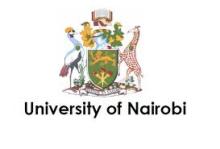Resource information
Sustainable management of the natural resources requires critical understanding of the dynamics of land use and land cover change (LULCC). Nguruman sub-catchment in the northern part of Kajiado County has experienced rapid land use and land cover changed over the past decades. However, the extent to which these changes have impacted on the ecosystem and indigenous livelihoods has not been assessed. This remains a critical challenge that must be addressed due to its potential severe impacts on rural human livelihoods especially in arid and semi-arid areas in Kenya. This study aimed at assessing the effects of LULCC from 1994 to 2014 on the indigenous livelihoods in Nguruman sub-catchment. In order to achieve a positive gain in management, the study aimed at investigating available options to engage the indigenous community in identifying and finding solutions to issues on management of land and water resources in the study area. An integrated approach combining
LANDSAT image analysis, household surveys using questionnaires, Focused Group Discussions (FGDs) and Participatory GIS (PGIS) was employed in the study. This approach allowed conceptualizing LULCC from both a scientific and an indigenous community perspective. Household surveys and FGDs were conducted in Entasopia, Pakasse, Nguruman, Musenge and Shompole locations. Significant land use changes (p<0.05) were recorded in cropland, open water, open grasslands and bareland. Areas occupied by croplands increased significantly and forestland reduced. There were fluctuations in areas occupied by wetlands in the form of swamps (vegetated wetlands) and open water (rivers, ponds and lakes). The fluctuation in the two land covers showed similar trends with both increasing between 1994 and 2014 and reductions between 2004 and 2014 reported. Areas occupied by open water increased significantly (p<0.05) by 1.15% (1994-2014). Significant (p<0.05) reduction in bareland was also recorded between 1994 and 2014. Open grasslands increased significantly (p<0.05) while wooded grasslands reduced though this was not significant. Expansion of cropland has been identified as the main driving force of land use changes in Nguruman sub-catchment. This implies that more land is being converted to cropland. The results of household surveys and PGIS analysis demonstrated that the residents are aware of the dynamics and causes of LULCC. Majority of the respondents (67%, n=204) linked the changes to an expansion in cropland while 31% and 2% associated the change to an expansion in open grassland and forestland respectively. Significant expansion (p < 0.05) in irrigated cropland was observed in both Pakasse and Entasopia sub-locations between 1994 and 2014. Results from household surveys reveal that there has been a sudden shift from a traditional pastoral livelihood to extensive agro-pastoral practices. This poses a critical challenge on both rural livelihood and will consequently have negative consequence on the current and future sustainability of the ecosystem. Additionally, expansion of irrigated cropping which has become a major economic activity in the study area will continue to exert more pressure on the scarce water resources in the catchment. Such pressure will be directed along the riparian land where availability of water suitable soil conditions for farming is guaranteed. There is need to identify and implement best management practices to sustainably manage land and water resources in Nguruman sub-catchment. This should involve all key stakeholders including local communities in identifying, designing and implementing sustainable strategies for land and water resources management in Nguruman sub-catchment.


